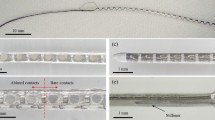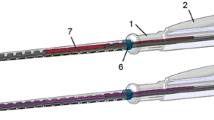Abstract
An atraumatic cochlear electrode array has become indispensable to high-performance cochlear implants such as electric acoustic stimulation (EAS), wherein the preservation of residual hearing is significant. For an atraumatic implantation, we propose and demonstrate a new improved design of a cochlear electrode array based on liquid crystal polymer (LCP), which can be fabricated by precise batch processes and a thermal lamination process, in contrast to conventional wire-based cochlear electrode arrays. Using a thin-film process of LCP-film-mounted silicon wafer and thermal press lamination, we devise a multi-layered structure with variable layers of LCP films to achieve a sufficient degree of basal rigidity and a flexible tip. A peripheral blind via and self-aligned silicone elastomer molding process can reduce the width of the array. Measuring the insertion and extraction forces in a human scala tympani model, we investigate five human temporal bone insertion trials and record electrically evoked auditory brainstem responses (EABR) acutely in a guinea pig model. The diameters of the finalized electrode arrays are 0.3 mm (tip) and 0.75 mm (base). The insertion force with a displacement of 8 mm from a round window and the maximum extraction force are 2.4 mN and 34.0 mN, respectively. The electrode arrays can be inserted from 360° to 630° without trauma at the basal turn. The EABR data confirm the efficacy of the array. A new design of LCP-based cochlear electrode array for atraumatic implantation is fabricated. Verification indicates that foretells the development of an atraumatic cochlear electrode array and clinical implant.










Similar content being viewed by others
References
M.H. Agterberg, H. Versnel, L. Dijk, J.M.J. Groot, S.L. Klis, Enhanced survival of spiral ganglion cells after cessation of treatment with brain-derived Neurotrophic factor in deafened guinea pigs. JARO 10(3), 355–367 (2009)
P.T. Bhatti, A High-Density Thin-Film Electrode Array for a Cochlear Prosthesis. PhD thesis. Electrical Engineering. The University of Michigan (2006)
B. Bhushan, Adhesion and stiction: Mechanisms, measurement techniques, and methods for reduction. J. Vac. Sci. Technol. B 21(6), 2262–2296 (2003)
E.Y. Chow, A.L. Chlebowski, P.P. Irazoqui, A miniature-implantable RF-wireless active glaucoma intraocular pressure monitor. IEEE Trans. Bio-Med. Circ. Syst. 4(6), 340–349 (2010)
E.C. Culbertson, A new laminate material for high performance PCBs: liquid crystal polymer copper clad films. In: Electronic Components and Technology Conference, 1995. Proceedings., 45th. pp 520–523 (1995)
A.A. Eshraghi, N.W. Yang, T.J. Balkany, Comparative study of cochlear damage with three perimodiolar electrode designs. Laryngoscope 113(3), 415–419 (2003)
A. Faulkner, S. Rosen, D. Stanton, Simulations of tonotopically mapped speech processors for cochlear implant electrodes varying in insertion depth. J. Acoust. Soc. Am. 113(2), 1073–1080 (2003)
J.N. Fayad, T. Baino, S.C. Parisier, Revision cochlear implant surgery: causes and outcome. Otolaryngol.--Head Neck Surg.: Off. J. Am. Acad. Otolaryngol.-Head Neck Surg. 131(4), 429–432 (2004)
D.D. Greenwood, A cochlear frequency‐position function for several species—29 years later. J. Acoust. Soc. Am. 87(6), 2592–2605 (1990)
C. Hassler, T. Boretius, T. Stieglitz, Polymers for neural implants. J. Polym. Sci. B Polym. Phys. 49(1), 18–33 (2011)
G.-T. Hwang, D. Im, S.E. Lee, J. Lee, M. Koo, S.Y. Park, S. Kim, K. Yang, S.J. Kim, K. Lee, K.J. Lee, In vivo silicon-based flexible radio frequency integrated circuits monolithically encapsulated with biocompatible liquid crystal polymers. ACS Nano 7(5), 4545–4553 (2013)
S. Irving, M.I. Trotter, J.B. Fallon, R.E. Millard, R.K. Shepherd, A.K. Wise, Cochlear implantation for chronic electrical stimulation in the mouse. Hear. Res. 306, 37–45 (2013)
K. Kang, I.S. Choi, Y. Nam, A biofunctionalization scheme for neural interfaces using polydopamine polymer. Biomaterials 32(27), 6374–6380 (2011)
T.G. Landry, A.K. Wise, J.B. Fallon, R.K. Shepherd, Spiral ganglion neuron survival and function in the deafened cochlea following chronic neurotrophic treatment. Hear. Res. 282(1–2), 303–313 (2011)
S.W. Lee, J.M. Seo, S. Ha, E.T. Kim, H. Chung, S.J. Kim, Development of microelectrode arrays for artificial retinal implants using liquid crystal polymers. Invest. Ophthalmol. Vis. Sci. 50(12), 5859–5866 (2009)
S.W. Lee, K.S. Min, J. Jeong, J. Kim, S.J. Kim, Monolithic encapsulation of implantable neuroprosthetic devices using liquid crystal polymers. IEEE Trans. Bio-Med. Eng. 58(8), 2255–2263 (2011)
C. Liu, Recent developments in polymer MEMS. Adv. Mater. 19(22), 3783–3790 (2007)
C.A. Miller, K.E. Woodruff, B.E. Pfingst, Functional responses from guinea pigs with cochlear implants. I. Electrophysiological and psychophysical measures. Hear. Res. 92(1–2), 85–99 (1995)
K.S. Min, A Study on the Liquid Crystal Polymer-Based Intracochlear Electrode Array. PhD thesis. Department of Electrical and Computer Engineering. Seoul National University, Seoul National University Library, (2014a)
K.S. Min, S.H. Oh, M.H. Park, J. Jeong, S.J. Kim, A polymer-based multichannel cochlear electrode array. Otol. Neurotol. 35(7), 1179–86 (2014b)
A. Mitchell, J.M. Miller, P.A. Finger, J.W. Heller, Y. Raphael, R.A. Altschuler, Effects of chronic high-rate electrical stimulation on the cochlea and eighth nerve in the deafened guinea pig. Hear. Res. 105(1–2), 30–43 (1997)
M. Müller, K. Hünerbein, S. Hoidis, J.W.T. Smolders, A physiological place–frequency map of the cochlea in the CBA/J mouse. Hear. Res. 202(1–2), 63–73 (2005)
S.C. Parisier, P.M. Chute, A.L. Popp, G.D. Suh, Outcome analysis of cochlear implant reimplantation in children. Laryngoscope 111(1), 26–32 (2001)
R. Pelrine, R. Kornbluh, J. Joseph, R. Heydt, Q. Pei, S. Chiba, High-field deformation of elastomeric dielectrics for actuators. Mater Sci. Eng.: C 11(2), 89–100 (2000)
M. Polak, A.A. Eshraghi, O. Nehme, S. Ahsan, J. Guzman, R.E. Delgado, J. He, F.F. Telischi, T.J. Balkany, T.R. Van De Water, Evaluation of hearing and auditory nerve function by combining ABR, DPOAE and eABR tests into a single recording session. J. Neurosci. Methods 134(2), 141–149 (2004)
S.J. Rebscher, M. Heilmann, W. Bruszewski, N.H. Talbot, R.L. Snyder, M.M. Merzenich, Strategies to improve electrode positioning and safety in cochlear implants. IEEE Trans. Bio-Med. Eng. 46(3), 340–352 (1999)
S.J. Rebscher, A. Hetherington, B. Bonham, P. Wardrop, D. Whinney, P.A. Leake, Considerations for design of future cochlear implant electrode arrays: electrode array stiffness, size, and depth of insertion. J. Rehabil. Res. Dev. 45(5), 731–747 (2008)
P. Sattayasoonthorn, J. Suthakorn, S. Chamnanvej, J. Miao, A.G.P. Kottapalli, LCP MEMS implantable pressure sensor for Intracranial Pressure measurement. In: Nano/Molecular Medicine and Engineering (NANOMED), 2013 I.E. 7th International Conference on. pp 63–67 (2013)
J.K. Scott Corbett, T. Johnson, Polymer-Based Microelectrode Arrays. In: Materials Research Society Symposium, (2006)
R. Shepherd, K. Verhoeven, J. Xu, F. Risi, J. Fallon, A. Wise, An improved cochlear implant electrode array for use in experimental studies. Hear. Res. 277(1–2), 20–27 (2011)
F.A. Spelman, Cochlear electrode arrays: past, present and future. Audiol Neuro Otol 11(2), 77–85 (2006)
O. Stakhovskaya, D. Sridhar, B. Bonham, P. Leake, Frequency Map for the human cochlear spiral ganglion: implications for cochlear implants. J. Assoc. Res. Otolaryngol. 8(2), 220–233 (2007)
T. Stöver, P. Issing, G. Graurock, P. Erfurt, Y. ElBeltagy, G. Paasche, T. Lenarz, Evaluation of the advance off-stylet insertion technique and the cochlear insertion tool in temporal bones. Otol. Neurotol. 26(6), 1161–1170 (2005)
S.E. Lee, S.B. Jun, H.J. Lee, J. Kim, S.W. Lee, C. Im, H.C. Shin, J.W. Chang, S.J. Kim, A flexible depth probe using liquid crystal polymer. IEEE Trans. Bio-Med. Eng. 59(7), 2085–2094 (2012)
C.J. Van Oss, R.J. Good, M.K. Chaudhury, The role of van der Waals forces and hydrogen bonds in “hydrophobic interactions” between biopolymers and low energy surfaces. J. Colloid Interface Sci. 111(2), 378–390 (1986)
J. Wang, K.D. Wise, A hybrid electrode array with built-in position sensors for an implantable MEMS-based cochlear prosthesis. J. Microelectromech. Syst. 17(5), 1187–1194 (2008)
J. Wang, K.D. Wise, A thin-film cochlear electrode array with integrated position sensing. J. Microelectromech. Syst. 18(2), 385–395 (2009)
P. Wardrop, D. Whinney, S.J. Rebscher, J.T. Roland Jr., W. Luxford, P.A. Leake, A temporal bone study of insertion trauma and intracochlear position of cochlear implant electrodes. I: comparison of nucleus banded and nucleus contour™ electrodes. Hear. Res. 203(1–2), 54–67 (2005)
A.D. Woolfson, R.K. Malcolm, S.P. Gorman, D.S. Jones, A.F. Brown, S.D. McCullagh, Self-lubricating silicone elastomer biomaterials. J. Mater. Chem. 13(10), 2465–2470 (2003)
W. Xuefeng, E. Jonathan, L. Chang, Liquid crystal polymer (LCP) for MEMS: processes and applications. J. Micromech. Microeng. 13(5), 628 (2003)
Acknowledgments
This work was supported in part by the Pioneer Research Center Program (NRF-2009-0082961) and the Public Welfare & Safety Research Program (NRF-2010-0020851) through the National Research Foundation of Korea funded by the Ministry of Science, ICT and Future Planning and in part by BK21 Plus Project, Department of Electrical and Computer Engineering, SNU in 2014
Author information
Authors and Affiliations
Corresponding author
Additional information
Tae Mok Gwon, Kyou Sik Min and Jin Ho Kim contributed equally to this work.
Rights and permissions
About this article
Cite this article
Gwon, T.M., Min, K.S., Kim, J.H. et al. Fabrication and evaluation of an improved polymer-based cochlear electrode array for atraumatic insertion. Biomed Microdevices 17, 32 (2015). https://doi.org/10.1007/s10544-015-9941-1
Published:
DOI: https://doi.org/10.1007/s10544-015-9941-1




